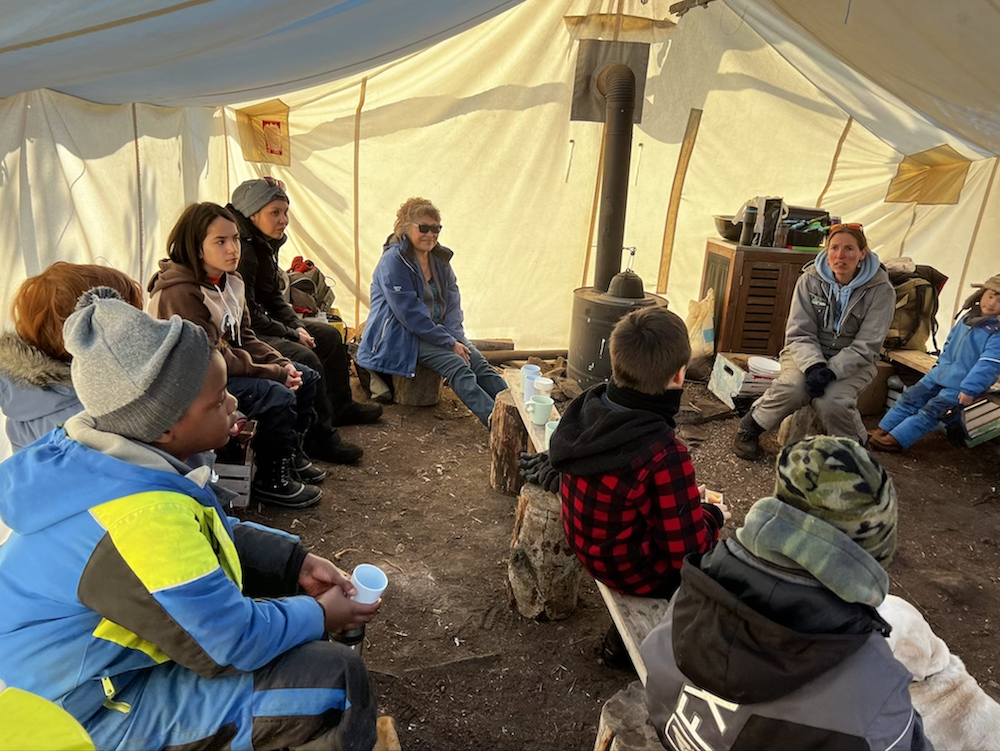Learning Story – “Land Leads Learning” on a Snowy Warm Day
The Week of November 22, 2022

What Happened?
We have had so much snowfall over the past month, and it snowed nonstop this Tuesday, with warm temperatures close to zero. This created specific challenges and learning and playing opportunities.
We checked the ice on the lake to see if it was safe to walk and play on. The continuing large snowfalls have meant that every day the ice condition changes. In addition to checking ice thickness with an axe at short intervals all the way across, we checked for overflow, which happens when the weight of the snow on top of the ice causes water to push up through cracks in the ice and around the edges. In some areas we detected a layer of slush on top of the ice that can be a hazard since it can get boots and mitts wet.
Despite the warm air temperature, we were surprised to find how difficult it was to stay warm as the day went on, since our mitts and snowsuits kept getting wet from the damp snow. We needed to change mitts many times and keep drying clothes out by the wood stove.
Some Bushkids melted snow in our “mud kitchen” pans over the fire, and let it freeze again into ice. One ice creation also contained guts from the Wıı̀lıı̀fish (inconnu/coney) that we cleaned and cooked today with help from educator Noni Paulette and Auntie Berna, who explained how important Wıı̀lıı̀is to the Yellowknives Dene (Wıı̀lıı̀deh) people, language, and region. On the side of the hill some Bushkids found some icicles, and reflected on the different forms that water takes in the winter–why it sometimes forms ice, sometimes snow—and how we can easily turn snow into ice, but how would we turn water into snow? How do the clouds do it??
A few Bushkids practised starting fires with a flint and steel and matches, and discovered it is much harder to start a fire in a snowstorm! Several others went hiking to Fairy Fortress and noticed that deep snow can trick us by covering up crevices we could fall into, so they figured out a way to test the ground first with sticks.
Why is all of this meaningful?
One of our core principles at Bushkids is “Land Leads Learning.” The Land is our teacher; it sets the agenda and determines what is most important to learn today when we are outside. Even skills we have practised before, like lighting fires or keeping our bodies warm, present new challenges and new learning as the Land and weather changes.
The Land teaches us not only about animals, plants, water, the environment around us, but it teaches us about ourselves—including our emotions and spiritual connections—and how to take care of each other and our community.
What does this mean for next time?
We always include some flexibility in our planning for upcoming Bushkids sessions, to allow the Land to set the direction and the agenda for our inquiries. We do prepare inquiries ahead of time based on previous explorations and the Bushkids’ own ideas for activities they would like to do. However, the rhythm and focus of each session will ultimately depend on the weather (eg. how cold/warm, how wet/dry), how it is possible to move across the landscape (eg. whether the lake is safe to walk/play on, how deep the snow is, etc), which animals and plants present themselves, and how these conditions affect our emotions, our energy, and our group dynamics.
